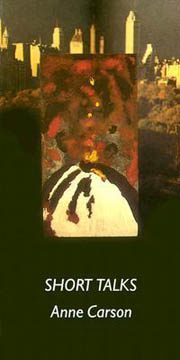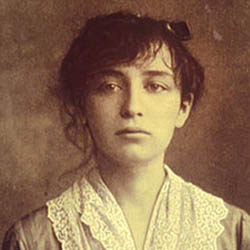I.
Forty-five short prose poems comprise Anne Carson’s Short Talks, or as Margaret Christakos describes them “forty-five taut rectangles of poetic address that each frame a seismic smithering of the human condition.” Short Talks, originally published in 1992, was Carson’s second collection. Now reprinted to inaugurate the Brick Books Classics series, Short Talks illuminates early concerns of Carson’s that unfold in her subsequent work.
What is a short talk? An aphorism? A riddle? A poetic burst of insight? In Carson’s hands, it is all of these and more. Consider her conclusion on “The Mona Lisa:” “But women are strong. She knew vessels, she knew water, she knew mortal thirst.” Carson links two objects—vessels and water—to evoke mortal thirst. Or consider the words she attributes to “Gertrude Stein About 9:30 P.M.:” “I had no idea! Today has ended.” I can hear Alice clucking in the background, yes, dear, today has ended. Carson’s short prose pieces bring ideas and images into a collision on the page. Then orange juice. A pile of rind and pith.
II.
 Reprints have a long history in publishing. In fact, successful publishing is driven by the backlist: published books that continue to sell. Publishers call them evergreens—books that people continue to read and discover, that teachers teach, that readers continue to need. Evergreens, though, do not go out of print; they may have new editions, anniversary celebrations, but they sell year in, year out. Impression upon impression.
Reprints have a long history in publishing. In fact, successful publishing is driven by the backlist: published books that continue to sell. Publishers call them evergreens—books that people continue to read and discover, that teachers teach, that readers continue to need. Evergreens, though, do not go out of print; they may have new editions, anniversary celebrations, but they sell year in, year out. Impression upon impression.
Reprints are books that have been forgotten. Forgotten by readers, forgotten by publishers. Reprints are books that perhaps did not perform well the first time in the market. Praised by critics, but overlooked by readers. Literary fiction. Poetry. Books that the publisher looked at the sales as the last book left the shelf and thought, eh, no need to go back to print. Reprints are lost gems. A gorgeous semi-precious stone perhaps in an antiquated or garish setting. A ring at the flea market that sparkles and shines, waiting for someone to repackage it, offer it with a proposal, wear it anew.
III.
Many of Carson’s short talks are haunted. Perhaps because the speaker’s mother “forbad us to walk backwards. That is how the dead walk, she would say.” Though the speaker explains that the dead “do not walk backwards but they do walk behind us. They have no lungs and cannot call out but would love for us to turn around. They are victims of love, many of them.”
Sometimes it is difficult to tell if the poems are haunted by death or by love. After explaining that “major things are wind, evil, a good fighting horse, prepositions, inexhaustible love, the way people choose their kings” and that “minor things include dirt, the names of schools of philosophy, mood and not having a mood, the correct time,” Carson writes,
When I think of you reading this I do not want you to be taken captive, separated by a wire mesh line with glass from your life itself, like some Elektra.
 Would it be a major thing or a minor thing to be “like some Elektra?” If one were like Elektra would one be haunted by love or by death?
Would it be a major thing or a minor thing to be “like some Elektra?” If one were like Elektra would one be haunted by love or by death?
Thinks of Camille Claudel, thirty years in an asylum. Things Claudel did not do: smoke, stroll, sculpt. “Although they gave her sleep stones—marble and granite and porphyry—she broke them, then collected the pieces and buried these outside the walls at night.” She also wrote to her brother, who signed the papers keeping her there. Was she “some Elektra”? Was she haunted by death? Or by love?
IV.
What drives a publisher to release a reprint? What drives the desire to commit to a full series of reprint titles like the Brick Books Classics series? The desire to keep works in print? To make beloved books available to new generations of readers? Is there a business case for the reprint? Can the commodity of an out of print book, abandoned by a previous publisher, unloved by readers, be transformed into an economic actor which at least breaks even, even if it eschews profit?
Does the linking of money and books offend? Do you prefer your poetry unsullied by commercial concerns? Mortal, immortal, ephemeral, beautiful? Unconcerned about currency? Greater in value than the paper on which it is printed, than the glue with which it is bound? More important than the labor of designers, graphic artists, booksellers, and publicists?
Why reprint editions? Why reprint series? What from the past enchants when the future promises so much more?
V.
I recently have undertaken a big reorganization of my books, dividing them into three genres: poetry, fiction, and nonfiction, then alphabetizing them. Suddenly all of the books by Donna Haraway are together, and all of the novels by Barbara Kingsolver. It is like a fun family reunion on my bookshelves with an author’s work restored to a single unit or a high school reunion with only the people you want to see. I have spent far too much time standing in front of my shelves marveling at the collection.
There were some quandaries. What to do about Marge Piercy and May Sarton? I have a solid collection of their prose and poetry and nonfiction. Should it all be shelved together? Divided by genre? I kept their work together and shelved it with fiction. Then the question: what to do about author biographies? With the subject’s work or alphabetized by the author of the biography? I shelved the Stevenson biography with Sexton’s poetry, but the Guest biography of H.D. is shelved with Guest’s work. I imagine at some point down the line, I will spend time looking for both, not remembering the logic of this moment in my life. For now, however, I can find books more easily, put my hands on them quickly. It aids writing. And I delight in the rows and rows of books. Organized. Like a library.
VI.
 In “Short Talk on My Task,” the poet confesses: “My task is to carry secret burdens for the world.” One of my tasks has been to purchase stacks of discounted overstock poetry. Books by beloved poets that in my opinion should not ever be reduced in price. I buy them at $1.98 or $2.98 or $3.98 or more. In large stacks. I give them away. Once a foolish discount chain had a whole stack of twenty books by Marilyn Hacker. I bought them all. I just gave away the last remaindered copy. I am like the poetry book rescue, fostering books until I can put them in the hands of owners who will love them.
In “Short Talk on My Task,” the poet confesses: “My task is to carry secret burdens for the world.” One of my tasks has been to purchase stacks of discounted overstock poetry. Books by beloved poets that in my opinion should not ever be reduced in price. I buy them at $1.98 or $2.98 or $3.98 or more. In large stacks. I give them away. Once a foolish discount chain had a whole stack of twenty books by Marilyn Hacker. I bought them all. I just gave away the last remaindered copy. I am like the poetry book rescue, fostering books until I can put them in the hands of owners who will love them.
Anne Carson’s tasks in the world are more recondite. She writes,
Yesterday morning at sunrise for example, you could have seen me on the breakwall carrying gauze. I also carry untimely ideas and sins in general or any faulty action that has been lowered together with you into this hour.
We all have work to do in the world.
VII.
Reorganizing my books exposes the various editions of books in my collection. My Walt Whitman pocket edition from high school, next to the scholarly edition I purchased for graduate school. I could not part with either. Though the truth is I prefer the yellowing pages of the pocket edition; how it makes me remember being a randy teenager and discovering Walt and all of his corporeal desires.
I have every edition of every book published by Marilyn Hacker and Minnie Bruce Pratt, for her I have not only different editions, but in one case different printings of the same book. I have almost every edition of every book by Judy Grahn. I suppose this makes me a collector of sorts, but collector suggests interest in the object alone. My affection, my interest extends beyond the book itself into the labor of publishing—stories of how manuscript pages became a book in the world. Picking up any book, I wonder, What causes people to put the time, effort, and money into publishing, particularly into publishing work that they know will not be commercially successful?
VIII.
 Cheryl Clarke jokes about friends who ask her, did you ever think your work would be classic? Let alone a Sapphic Classic? How long before work becomes classic? Cheryl Clarke’s book Living as a Lesbian, originally published by Firebrand Books in 1986, was the second Sapphic Classic published by Sinister Wisdom and A Midsummer Night’s Press in 2014.
Cheryl Clarke jokes about friends who ask her, did you ever think your work would be classic? Let alone a Sapphic Classic? How long before work becomes classic? Cheryl Clarke’s book Living as a Lesbian, originally published by Firebrand Books in 1986, was the second Sapphic Classic published by Sinister Wisdom and A Midsummer Night’s Press in 2014.
I initiated the series. I wanted lesbians to have the experience of discovering and reading the books that were so important to me as a younger reader and that are now increasingly out of print. I wanted to be a maker of something important to my reading past; I wanted to make the past present. Many women poets have been rediscovered to new generations of readers through reprint editions, particular reprints initiated by feminist publishers. I think of Barbara Grier’s editions of Renee Vivien and Gertrude Stein. I think of my own publishing with Sinister Wisdom, of our Sapphic Classics. I think of Lisa Moore’s reprint editions at Redbone Press and the reprints being done by Valancourt Press. People investing time and money to create an object to press into your hands whispering, here, read this.
We read, we reread, we return to books we love, placing them in a new context. Staking their significance again for new readers. This process is akin to the divine.
VI.
Carson concludes Short Talks with “Short Talk on Who You Are:”
I want to know who you are. People talk about a voice calling in the wilderness. All through the Old Testament a voice, which is not the voice of God but which knows what is on God’s mind, is crying out. While I am waiting, you could do me a favour. Who are you?
Who are you, indeed, to bring a book into the world. A reprint. A book already published, consumed. One with a life before. A book once gone, now rediscovered, reprinted, recovered. Perhaps you are a publisher or soon-to-be publisher, creating a reprint edition. Who are you? The one who hears the voice of God?




